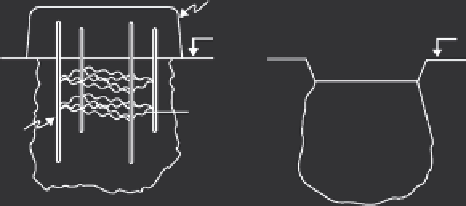Environmental Engineering Reference
In-Depth Information
Hood
Ground
surface
Ground
surface
Soil
Soil
Electric
current
Electrodes
Glass-like
block
Melted
soil
During vitrification
After vitrification
FIGURE 11.11
Example of vitrification. (From United States Environmental Protection Agency (USEPA),
A Citizen's Guide to
Vitrification,
, EPA 542-F-01-0015, Office of Solid Waste and Emergency Response, Washington, DC, 2001f.)
accomplished by four rods called electrodes. The electrodes are placed into the contami-
nated soil and an electrical current passed between them results in the melting of inter-
vening soil.
When the electrodes are turned off, the soil cools and vitrifies into a glass-like substance
that entombs the contaminants. Vitrified soil often has significantly less volume because
the original grain to grain contacts have been fused together and any porosity of the vitri-
fied material is eliminated (USEPA 2001f).
An example of vitrification is shown in Figure 11.11.
11.3.16 Chemical Oxidation
In chemical oxidation, the addition of an oxidizing agent to contaminated soil results
in two possible outcomes: (1) the complete destruction of the contaminants or (2) it pro-
duces a source of oxygen capable of inducing more rapid rates of bioremediation as long
as the correct dosage is used. This technology can be very effective for remediating many
organic compounds, including some DNAPL compounds, provided the correct dosages
are applied and the chemicals can be delivered to the location where the contaminants
reside in the subsurface. Common oxidizing agents include (USEPA 2007):
• Ozone
• Hydrogen peroxide
• Sodium percarbonate
• Sodium permanganate
• Potassium permanganate
• Sodium persulfate
11.3.17 Chemical Dehalogenation
Chemical dehalogenation is a remedial method that removes
halogens
from contaminants.
As noted in Chapter 7, halogens are contaminants containing halogen atoms within their
atomic structure. Halogens include fluorine, chlorine, bromine, and iodine. Common halo-
genated contaminants include several DNAPL VOCs, PCBs and dioxins.
The process of chemical dehalogenation involves the excavation of contaminated soil. The
soil is sifted and crushed to remove larger objects and enable better remedial treatment.

Search WWH ::

Custom Search